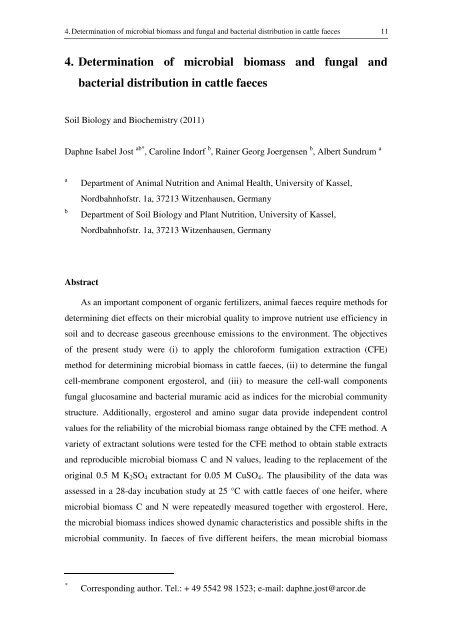Fütterungsbedingte mikrobielle Zusammensetzung von Rinderkot ...
Fütterungsbedingte mikrobielle Zusammensetzung von Rinderkot ...
Fütterungsbedingte mikrobielle Zusammensetzung von Rinderkot ...
You also want an ePaper? Increase the reach of your titles
YUMPU automatically turns print PDFs into web optimized ePapers that Google loves.
4. Determination of microbial biomass and fungal and bacterial distribution in cattle faeces 11<br />
4. Determination of microbial biomass and fungal and<br />
bacterial distribution in cattle faeces<br />
Soil Biology and Biochemistry (2011)<br />
Daphne Isabel Jost ab* , Caroline Indorf b , Rainer Georg Joergensen b , Albert Sundrum a<br />
a Department of Animal Nutrition and Animal Health, University of Kassel,<br />
Nordbahnhofstr. 1a, 37213 Witzenhausen, Germany<br />
b Department of Soil Biology and Plant Nutrition, University of Kassel,<br />
Nordbahnhofstr. 1a, 37213 Witzenhausen, Germany<br />
Abstract<br />
As an important component of organic fertilizers, animal faeces require methods for<br />
determining diet effects on their microbial quality to improve nutrient use efficiency in<br />
soil and to decrease gaseous greenhouse emissions to the environment. The objectives<br />
of the present study were (i) to apply the chloroform fumigation extraction (CFE)<br />
method for determining microbial biomass in cattle faeces, (ii) to determine the fungal<br />
cell-membrane component ergosterol, and (iii) to measure the cell-wall components<br />
fungal glucosamine and bacterial muramic acid as indices for the microbial community<br />
structure. Additionally, ergosterol and amino sugar data provide independent control<br />
values for the reliability of the microbial biomass range obtained by the CFE method. A<br />
variety of extractant solutions were tested for the CFE method to obtain stable extracts<br />
and reproducible microbial biomass C and N values, leading to the replacement of the<br />
original 0.5 M K2SO4 extractant for 0.05 M CuSO4. The plausibility of the data was<br />
assessed in a 28-day incubation study at 25 °C with cattle faeces of one heifer, where<br />
microbial biomass C and N were repeatedly measured together with ergosterol. Here,<br />
the microbial biomass indices showed dynamic characteristics and possible shifts in the<br />
microbial community. In faeces of five different heifers, the mean microbial biomass<br />
* Corresponding author. Tel.: + 49 5542 98 1523; e-mail: daphne.jost@arcor.de
















